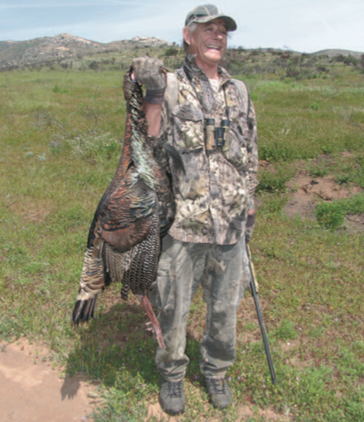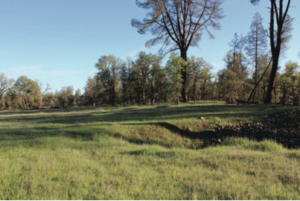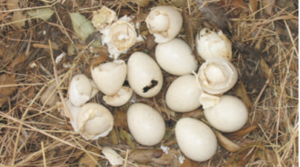
BY TIM E. HOVEY
Whether you’re hunting turkeys on private or public land during the spring, the tactics needed to locate birds and bring them close really doesn’t change. In my opinion, knowing the lay of the land and searching for sign is your first step. And all that starts with scouting.
Most of my turkey hunting experience was acquired on public land and prior to the spring season I will always set aside some time to scout the areas I want to hunt. These outings are observation trips only and while there is a strong urge to locate birds through pre-season calling, I don’t do it. I believe the risk of being seen and educating those hard-to- find birds is too great and I’d rather sneak in, gather information and sneak back out during my scouting trips.
One of the first things you may find surprising is that turkeys are found in 54 of the 58 counties here in California. Obviously, in some regions turkeys are far more abundant, but if you put in the time, a turkey hunter can be successful on public land. Public lands like CDFW hunting property, U.S. Forest Service land, BLM and other public parcels are all open for hunting and public access.
I start my initial scouting trip during the late morning and I focus on finding a consistent water source. Turkeys will water a couple of times a day and will seldom be far from that source during their daily travels. Searching the muddy banks of a hidden spring or creek for turkey tracks is where I start. Even if I don’t find fresh tracks, I’ll make note of that water source and move on.

It’s also important to understand what kind of habitat wild turkeys use during their daily travels as well as throughout their life cycle. Turkeys roost every evening in large trees with strong horizontal branches. Trees like gray pine, sycamores, cottonwoods, black oak and ponderosa pines are all favored roosting trees of turkeys. Becoming familiar with what these trees look like will definitely help in zeroing in on a group of birds. If you find a roosting tree in close association with a water source, you’re on the right track.
Turkeys will often use the same roosting tree day after day, littering the area around the trunk with droppings and feathers. If you’re unsure if birds are using the tree, check the base. In some cases, a crude line of droppings can actually show you which branch they roost on throughout the night.
Once you’ve located potential roosting areas, start searching the location for nesting cover and brooding areas. Coupled with a reliable food and water source, hens will lay their eggs in areas of cover where they can usually tend to them without predator detection. Thick riparian understory or brushy areas that are tough for anything larger than a turkey to move through are ideal for nesting hens. Berry bushes and trees that produce acorns, both food for the young turkey, will also be a plus when searching for these potential nesting locations. Find these brushy piles in close proximity to the roosting trees and turkeys should be close by.
If you’re confident you’ve located an area that holds birds, spend some time looking for a suitable set up spot. I like to sit in shady cover that helps me stay undetected. If this location is close to a roosting tree, I’ll work out a pathway to get to my set up spot without being detected by roosting birds. If I’m hunting in the morning and hoping to catch birds coming off the roost, this means I’m arriving in the dark.
Open areas adjacent to shady cover will be ideal for setting up a decoy or two. Over the last decade during the spring hunts, I’ve shifted from just a hen decoy to a hen and jake set up. Mature toms will aggressively confront and fight jakes, especially when he feels that the younger turkey is trying to mate a hen. This blind rage will often pull tom turkeys close and focus their attention on your set up, giving prepared hunters a chance for a shot. Place a lone jake decoy in close proximity of the hen and get ready for fireworks.

Your mismatch decoy set up means little, however, if the turkeys never see it. This is where the calling comes into play. I am of the strong opinion that more calling in this situation is not always better. Almost all the turkey hunts I’ve been on, the calling used to bring birds close has been minimal. I’m not sure if too much calling seems unnatural to love-crazed toms or it just turns them off, but calling sparingly seems to peak their interest convincing them to at least investigate. A few hen purrs and clucks to get the attention of interested gobblers is all you need. If you get a response from your calling, put down the call and pay attention, birds are likely coming.
One of the things that always amazed me when hunting turkeys is how quietly these big birds can move through the riparian leaf litter. Often you’ll just see a head peak through the brush or all of a sudden they’re just there. Be prepared for these sudden appearances and have your shotgun up and ready.
I’ve hunted all my life and nothing excites me more than fooling an animal into range. Using decoys and a few sounds to get a tom to come close is as about as exciting as you can get. Knowing that you spent the time to scout an area, find birds and figure out their patterns makes it all the more rewarding. Stay still, call sparingly and good luck out there this spring.



